OCZ Vertex 3 (240GB) Review
by Anand Lal Shimpi on May 6, 2011 1:50 AM ESTAnandTech Storage Bench 2011
Last year we introduced our AnandTech Storage Bench, a suite of benchmarks that took traces of real OS/application usage and played them back in a repeatable manner. I assembled the traces myself out of frustration with the majority of what we have today in terms of SSD benchmarks.
Although the AnandTech Storage Bench tests did a good job of characterizing SSD performance, they weren't stressful enough. All of the tests performed less than 10GB of reads/writes and typically involved only 4GB of writes specifically. That's not even enough exceed the spare area on most SSDs. Most canned SSD benchmarks don't even come close to writing a single gigabyte of data, but that doesn't mean that simply writing 4GB is acceptable.
Originally I kept the benchmarks short enough that they wouldn't be a burden to run (~30 minutes) but long enough that they were representative of what a power user might do with their system.
Not too long ago I tweeted that I had created what I referred to as the Mother of All SSD Benchmarks (MOASB). Rather than only writing 4GB of data to the drive, this benchmark writes 106.32GB. It's the load you'd put on a drive after nearly two weeks of constant usage. And it takes a *long* time to run.
Here's a high level overview:
1) The MOASB, officially called AnandTech Storage Bench 2011 - Heavy Workload, mainly focuses on the times when your I/O activity is the highest. There is a lot of downloading and application installing that happens during the course of this test. My thinking was that it's during application installs, file copies, downloading and multitasking with all of this that you can really notice performance differences between drives.
2) I tried to cover as many bases as possible with the software I incorporated into this test. There's a lot of photo editing in Photoshop, HTML editing in Dreamweaver, web browsing, game playing/level loading (Starcraft II & WoW are both a part of the test) as well as general use stuff (application installing, virus scanning). I included a large amount of email downloading, document creation and editing as well. To top it all off I even use Visual Studio 2008 to build Chromium during the test.
Digging a little deeper, the test has 2,168,893 read operations and 1,783,447 write operations. The IO breakdown is as follows:
| AnandTech Storage Bench 2011 - Heavy Workload IO Breakdown | ||||
| IO Size | % of Total | |||
| 4KB | 28% | |||
| 16KB | 10% | |||
| 32KB | 10% | |||
| 64KB | 4% | |||
Only 42% of all operations are sequential, the rest range from pseudo to fully random (with most falling in the pseudo-random category). Average queue depth is 4.625 IOs, with 59% of operations taking place in an IO queue of 1.
Many of you have asked for a better way to really characterize performance. Simply looking at IOPS doesn't really say much. As a result I'm going to be presenting Storage Bench 2011 data in a slightly different way. We'll have performance represented as Average MB/s, with higher numbers being better. At the same time I'll be reporting how long the SSD was busy while running this test. These disk busy graphs will show you exactly how much time was shaved off by using a faster drive vs. a slower one during the course of this test. Finally, I will also break out performance into reads, writes and combined. The reason I do this is to help balance out the fact that this test is unusually write intensive, which can often hide the benefits of a drive with good read performance.
There's also a new light workload for 2011. This is a far more reasonable, typical every day use case benchmark. Lots of web browsing, photo editing (but with a greater focus on photo consumption), video playback as well as some application installs and gaming. This test isn't nearly as write intensive as the MOASB but it's still multiple times more write intensive than what we were running last year.
As always I don't believe that these two benchmarks alone are enough to characterize the performance of a drive, but hopefully along with the rest of our tests they will help provide a better idea.
The testbed for Storage Bench 2011 has changed as well. We're now using a Sandy Bridge platform with full 6Gbps support for these tests. All of the older tests are still run on our X58 platform.
AnandTech Storage Bench 2011 - Heavy Workload
We'll start out by looking at average data rate throughout our new heavy workload test:

The breakdown of reads vs. writes tells us more of what's going on:
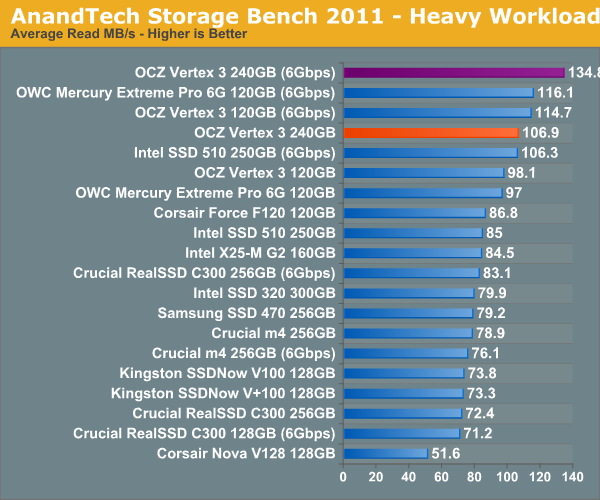
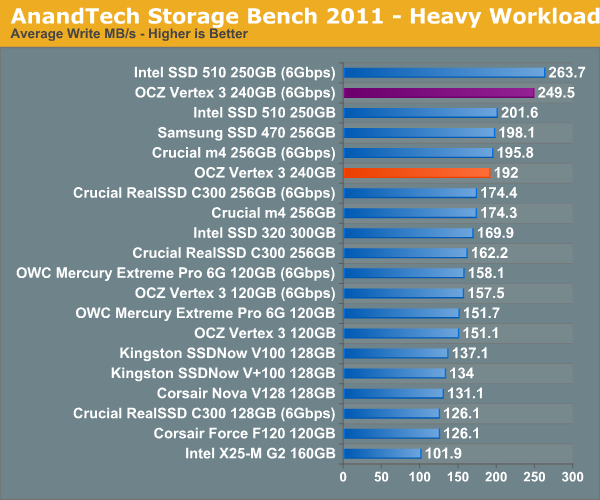
The next three charts just represent the same data, but in a different manner. Instead of looking at average data rate, we're looking at how long the disk was busy for during this entire test. Note that disk busy time excludes any and all idles, this is just how long the SSD was busy doing something:
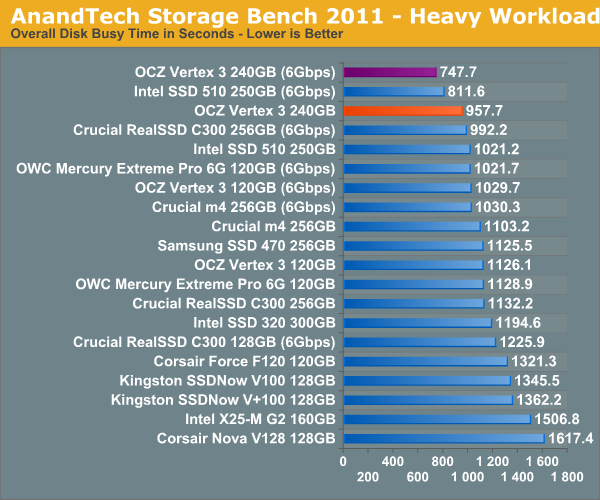
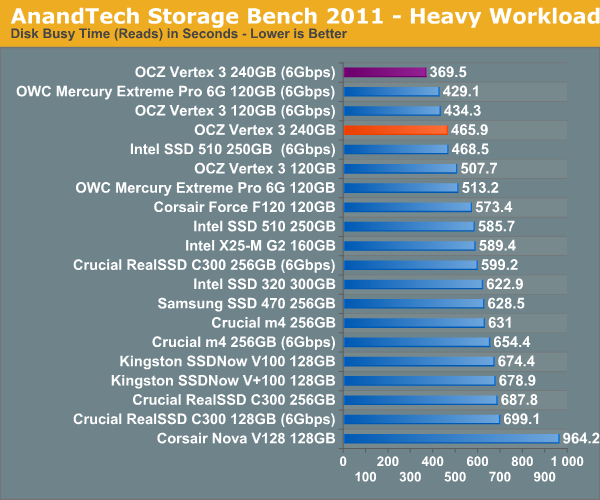
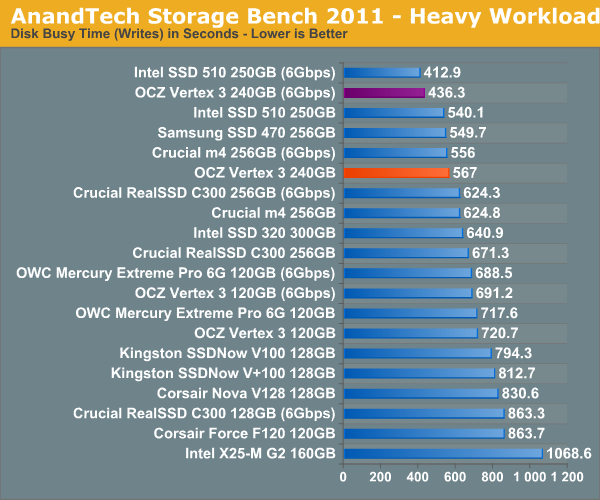










90 Comments
View All Comments
fowldogs - Friday, May 6, 2011 - link
Anand,I have recently researched which SSD to purchase and from several reviews, your's as well as many others, the OCZ Vertex 2 or 3 seemed like the best choice for performance. However, as I read consumer reviews on different shopping sight (Newegg, Amazon, etc), the Vertex 2 and 3 drives received numerous low reviews; including many that said the drive died on them soon after purchase.
Can you shed any light on this? Have you had any discussions with OCZ about their quality? I know that Mac's can be very finicky about SSD drives, but it seems many PC users were encountering problems too.
For now, I have decided on a Crucial drive, but I would like to know more about the quality issues of OCZ.
Omid.M - Friday, May 6, 2011 - link
If it's a ribbon cable issue for the 6 Gbps interface, then it would make the most sense to get the Intel 320 series SSD. Take a look on MacRumors about this drive versus Vertex 3 in the MBP, especially the 2011 models.Many more people are having good luck with Intel 320 than with Vertex 3. Sad.
Maybe someone should tweet and email OCZ about it, given how closely they seemed to be working with AnandTech to address reliability issues?
@moids
dagamer34 - Friday, May 6, 2011 - link
Always follow the law of reviews: no one actively thinks to leave a positive review, people always glamor for attention with negative reviews.darwinosx - Friday, May 6, 2011 - link
Yes but there is a critical mass of people with issues and much commonality among their complaints so that doesn't really work here.seapeople - Saturday, May 7, 2011 - link
Yes, but when Intel drives get 3% of 1-star ratings and the Vertex 2 gets 20% of 1-star ratings with numerous people claiming multiple RMA's, it makes you think there's a significant difference in reliability.Anand Lal Shimpi - Friday, May 6, 2011 - link
Perhaps a little background is in order :)Whenever I hear about a failure of any component from one of our readers (either via a comment, email, twitter, etc...), I forward it on to the manufacturer of the product. Usually this results in two things: 1) the AT reader getting taken care of a little quicker than normal, and 2) the manufacturer getting the faulty product back sooner so they can figure out what went wrong. I do this with all products but SSDs are the most common given the large amount of growing pains we've had there as an industry.
For a while there I was spending a lot of time talking to OCZ about failed Vertex 2s. Unfortunately I was traveling a lot at the start of it and didn't have time to pursue in great depth, but I alerted OCZ that there seemed to be a growing trend and asked for an explanation. Meanwhile I believe OCZ also saw the same trend, determined a root cause and addressed it.
OCZ has the problem of being a relatively small company competing amongst much larger ones in the SSD space. As a result there's pressure to scale production but it's near impossible to quickly scale without missing something and it seems like quality has suffered at distinct points in its history. Each time OCZ usually makes good by its customers, but it's still a risk associated with buying from a smaller company vs. an Intel for example. I do believe the trend is generally positive, I do expect the Vertex 3 to be more reliable and consistent than anything in OCZ's past - but for utmost reliability, Intel seems to have the best return rates in the industry for SSDs.
I have been meaning to check out OCZ's new manufacturing facilities which may give me some more insight into its investment in production and testing. I know on the validation side OCZ is leaps and bounds better than it was 2 years ago (I spent a lot of time discussing validation with OCZ back in the Vertex 1, Vertex 2 and Core days) but I'm not sure where they stand in terms of production.
The Mac problems I believe are separate. There's a problem with some (not all) MBPs and some SSDs but I can't figure out what. OWC seems to think that the problems on the 17-inch 2011 MBPs are related to EMI and Apple's quirky SATA cable - I suspect this may extend to all of the models, I honestly just haven't had the time to test it.
Take care,
Anand
darwinosx - Friday, May 6, 2011 - link
OWC is the one that made the false claims about OCZ ram specs (which you debunked) and they also sell a replacement cable. So I don't take anything they say very seriously. Weren't you the one who said manufacturers should ship to get things out even if they weren't quite ready? A post I strongly disagree with and is likely the cause of OCZ's troubles.cactusdog - Friday, May 6, 2011 - link
Its really a shame you get a big performance hit with the 120GB version. Its easy to see how the marketing works.....first release the fast 240Gb version, once the reviews are up, release the slower mainstream 120GB version and hope no one looks at the fine print.thornburg - Friday, May 6, 2011 - link
I realize that you're a big believer in the SandForce drives, but where are the reviews of other products?Is Intel the only one able to get any coverage?
Where are the reviews of the new Samsung SSDs?
NCM - Friday, May 6, 2011 - link
Somebody is sure in love with their 4-die NAND packages! Enough that the 480GB drive costs well over triple the price of the 240GB version, even though virtually everything but the NAND should be the same. I could see a 480GB SSD for a grand, but $1800? (Or a 320GB for $750.) That's silly money, and a self-fullfilling prophecy to boot: they don't sell because they're so expensive because there's no production volume.Anand, to repeat somebody else's request in one of your previous SSD reviews, could you please include a typical 5400 rpm laptop drive in your power consumption comparisons? (The Seagate Momentus XT 500 hybrid doesn't really count as typical.)